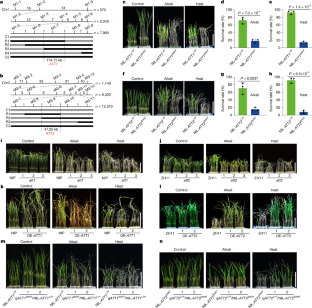Fine-tuning gibberellin improves rice alkali–thermal tolerance and yield
IF 50.5
1区 综合性期刊
Q1 MULTIDISCIPLINARY SCIENCES
引用次数: 0
Abstract
Soil alkalinization and global warming are predicted to pose major challenges to agriculture in the future, as they continue to accelerate, markedly reducing global arable land and crop yields1,2. Therefore, strategies for future agriculture are needed to further improve globally cultivated, relatively high-yielding Green Revolution varieties (GRVs) derived from the SEMIDWARF 1 (SD1) gene3,4. Here we propose that precise regulation of the phytohormone gibberellin (GA) to optimal levels is the key to not only confer alkali–thermal tolerance to GRVs, but also to further enhance their yield. Endogenous modulation of ALKALI-THERMAL TOLERANCE 1/2 (ATT1/2), quantitative trait loci encoding GA20-oxidases or exogenous application of GA minimized rice yield loss affected by sodic soils. Mechanistically, high GA concentrations induce reactive oxygen species over-accumulation, whereas low GA concentrations repress the expression of stress-tolerance genes by means of DELLA–NGR5-mediated H3K27me3 methylation. We further showed that ATT1 induces large fluctuations in GA levels, whereas ATT2 is the ideal candidate for fine-tuning GA concentrations to appropriate levels to balance reactive oxygen species and H3K27me3 methylation to improve alkali–thermal tolerance and yield. Thus, ATT2 is expected to be a potential new post-Green Revolution gene that could be harnessed to develop and use marginal lands for sustainable agriculture in the future. Precise regulation of the phytohormone gibberellin to optimal levels may not only confer alkali–thermal tolerance to Green Revolution rice varieties but may also further enhance their yield, and ATT2, by enabling the fine-tuning of gibberellins, is expected to be a potential new post-Green Revolution gene.


微调赤霉素可提高水稻的耐碱耐热性和产量
土壤碱化和全球变暖预计将在未来对农业构成重大挑战,因为它们将继续加速,显著减少全球耕地和作物产量1,2。因此,未来农业需要采取策略,进一步改善全球种植的、相对高产的、源自半干旱1 (SD1)基因3,4的绿色革命品种(grv)。本文提出,调控植物激素赤霉素(giberellin, GA)达到最佳水平,不仅是提高grv耐碱耐热性的关键,也是进一步提高其产量的关键。内源调节碱热耐受性1/2 (ATT1/2),编码ga20氧化酶的数量性状位点或外源施用GA可最大限度地减少碱土对水稻产量的影响。在机制上,高GA浓度诱导活性氧过度积累,而低GA浓度通过della - ngr5介导的H3K27me3甲基化抑制胁迫耐受基因的表达。我们进一步发现,ATT1诱导GA水平大幅波动,而ATT2则是将GA浓度微调到适当水平以平衡活性氧和H3K27me3甲基化以提高碱热耐受性和产量的理想候选。因此,ATT2有望成为一种潜在的后绿色革命新基因,未来可用于开发和利用边际土地进行可持续农业。
本文章由计算机程序翻译,如有差异,请以英文原文为准。
求助全文
约1分钟内获得全文
求助全文
来源期刊

Nature
综合性期刊-综合性期刊
CiteScore
90.00
自引率
1.20%
发文量
3652
审稿时长
3 months
期刊介绍:
Nature is a prestigious international journal that publishes peer-reviewed research in various scientific and technological fields. The selection of articles is based on criteria such as originality, importance, interdisciplinary relevance, timeliness, accessibility, elegance, and surprising conclusions. In addition to showcasing significant scientific advances, Nature delivers rapid, authoritative, insightful news, and interpretation of current and upcoming trends impacting science, scientists, and the broader public. The journal serves a dual purpose: firstly, to promptly share noteworthy scientific advances and foster discussions among scientists, and secondly, to ensure the swift dissemination of scientific results globally, emphasizing their significance for knowledge, culture, and daily life.
 求助内容:
求助内容: 应助结果提醒方式:
应助结果提醒方式:


